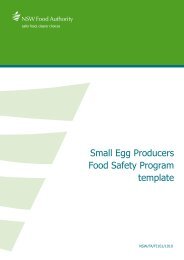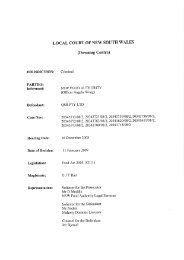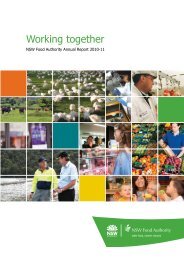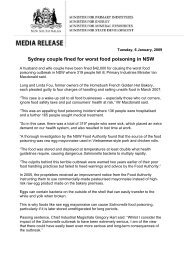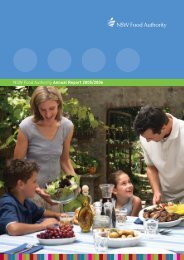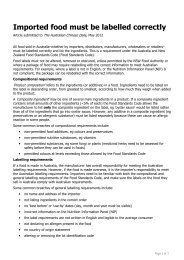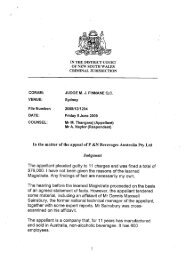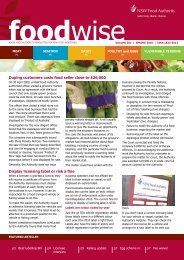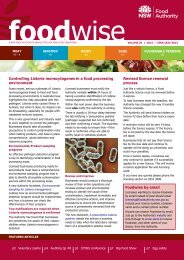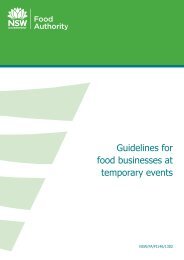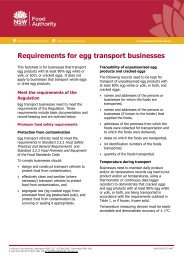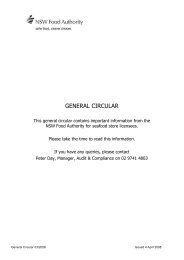Publication | Guideline for Seafood Retailers - NSW Food Authority
Publication | Guideline for Seafood Retailers - NSW Food Authority
Publication | Guideline for Seafood Retailers - NSW Food Authority
You also want an ePaper? Increase the reach of your titles
YUMPU automatically turns print PDFs into web optimized ePapers that Google loves.
<strong>Guideline</strong> <strong>for</strong> <strong>Seafood</strong><strong>Retailers</strong> –Compliance with the<strong>Food</strong> Standards Code<strong>NSW</strong> <strong>Food</strong> <strong>Authority</strong>6 Avenue of the AmericasNewington <strong>NSW</strong> 2127Australia
<strong>Guideline</strong> <strong>for</strong> <strong>Seafood</strong> <strong>Retailers</strong> –Compliance with the <strong>Food</strong> Standards CodeIntroductionThe <strong>NSW</strong> <strong>Food</strong> <strong>Authority</strong> is the state government agency responsible <strong>for</strong>ensuring that food in <strong>NSW</strong> is safe and correctly labelled and that consumersare able to make in<strong>for</strong>med choices about the food they eat.<strong>NSW</strong> <strong>Food</strong> <strong>Authority</strong> <strong>Food</strong> Safety Officers and Local Government EnvironmentalHealth Officers are Authorised Officers under section 37 of the <strong>NSW</strong> <strong>Food</strong> Act2003 (the ‘Act’) and have wide powers which include the power to enter andinspect premises and inspect any records relating to the sale of food.Whilst the <strong>NSW</strong> <strong>Food</strong> <strong>Authority</strong> aims to educate industry and assist them withmeeting their responsibilities, under the Act the <strong>Authority</strong> can, and will,prosecute businesses if they fail to comply.This <strong>Guideline</strong> has been developed by the <strong>NSW</strong> <strong>Food</strong> <strong>Authority</strong> toassist seafood retailers in meeting the food safety and labellingrequirements outlined in the Australia New Zealand <strong>Food</strong> StandardsCode, which is law in Australia.This is a guidance document and may not list all the requirementsthat your business needs to comply with. Businesses should refer tothe Act, <strong>NSW</strong> <strong>Food</strong> Regulation 2004 and the <strong>Food</strong> Standards Code <strong>for</strong>complete requirements. <strong>NSW</strong> legislation can be found atwww.legislation.nsw.gov.au and the <strong>Food</strong> Standards Code atwww.foodstandards.gov.au.Date Issued: 10/04/07 Version: 1 Page 3 of 23
<strong>Guideline</strong> <strong>for</strong> <strong>Seafood</strong> <strong>Retailers</strong> –Compliance with the <strong>Food</strong> Standards CodePurpose and ScopeThis <strong>Guideline</strong> has been designed specifically to assist seafood retailers inunderstanding the requirements of the <strong>Food</strong> Standards Code that are relevantto their business. It addresses food safety issues and labelling requirementsencountered by seafood retailers. It also addresses other issues relevant toseafood retailers, such as notification requirements, product substitution,disposal, temporary events and charity fish auctions.Certain seafood businesses, such as those involved in the wholesale andtransport of seafood, must be licensed with the <strong>NSW</strong> <strong>Food</strong> <strong>Authority</strong> under the<strong>Seafood</strong> Safety Scheme, and must ensure their business meets therequirements of the Scheme in addition to the requirements outlined in thisdocument.Businesses that per<strong>for</strong>m wet storage operations will be expected to implementcontrols that achieve the requirements of the <strong>NSW</strong> Shellfish ProgramOperations Manual (www.foodauthority.nsw.gov.au/industry/fb-shellfish.htm).This <strong>Guideline</strong> does not address Occupational Health and Safety orenvironmental requirements.Use of <strong>Guideline</strong>sIn this <strong>Guideline</strong>, the <strong>Food</strong> Standards Code requirements <strong>for</strong> seafood retailersare identified in boxes. Following the boxed areas is in<strong>for</strong>mation on how tomeet these requirements.This <strong>Guideline</strong> should be read in conjunction with other <strong>NSW</strong> <strong>Food</strong> <strong>Authority</strong><strong>Guideline</strong>s and Codes of Practice such as the Code of Practice <strong>for</strong> <strong>Seafood</strong>Handling Premises and <strong>Guideline</strong>s <strong>for</strong> the Wet Storage of Shellfish (refer toReferences <strong>for</strong> full list of documents).Acknowledgements• Mr Harry Peters, Marine Product Marketing• Mr Bryan Skepper, Sydney Fish Markets• Mr Graeme Turk, Sydney Fish Markets• Mr John Roach, Formerly Master Fish Merchants Association, Australia• Mr Michael Kitchener, Master Fish Merchants Association, Australia• Mr Kerry Strangas, Master Fish Merchants Association, AustraliaDate Issued: 10/04/07 Version: 1 Page 4 of 23
<strong>Guideline</strong> <strong>for</strong> <strong>Seafood</strong> <strong>Retailers</strong> –Compliance with the <strong>Food</strong> Standards CodeDefinitionsBatchCleanControlDepuration<strong>Food</strong> businessHazardImperviousPotable waterPotentially hazardous foodReady-to-eat foodSanitiseA quantity of bivalve molluscs which is harvested, depurated orhandled from the same lease number and with the same harvestdateMeans clean to touch and free of extraneous visible matter andobjectionable odourA measure that prevents, eliminates or reduces to an acceptablelevel, a food safety hazardA process using a controlled environment to reduce the level ofcertain pathogenic organisms that may be present in live shellfishand crustaceansA business, enterprise or activity (other than primary foodproduction) that involves –a. the handling of food intended <strong>for</strong> sale; orb. the sale of food;regardless of whether the business, enterprise or activityconcerned is of a commercial, charitable or community nature orwhether it involves the handling or sale of food on one occasiononlyMeans a biological, chemical or physical agent in, or condition of,food that has the potential to cause an adverse health effect inhumansMeans will not absorb water, moisture or greaseWater that is acceptable <strong>for</strong> human consumption.The Australian Drinking Water <strong>Guideline</strong>s are usedas a reference guide <strong>for</strong> potable waterMeans food that has to be kept at certain temperatures tominimise the growth of any pathogenic micro-organisms that maybe present in the food or to prevent the <strong>for</strong>mation of toxins in thefoodMeans food that is ordinarily consumed in the same state as thatin which it is sold and does not include nuts in the shell andwhole, raw fruits and vegetables that are intended <strong>for</strong> hulling,peeling or washing by the consumerMeans to apply heat or chemicals, heat and chemicals, or otherprocesses, to a surface so that the number of micro-organisms onthe surface is reduced to a level thata. does not compromise the safety of food with which it maycome into contact; andb. does not permit the transmission of infectious diseaseDate Issued: 10/04/07 Version: 1 Page 5 of 23
<strong>Guideline</strong> <strong>for</strong> <strong>Seafood</strong> <strong>Retailers</strong> –Compliance with the <strong>Food</strong> Standards Code<strong>Seafood</strong><strong>Seafood</strong> business (<strong>Food</strong>Regulation 2004)<strong>Seafood</strong> retailerShellfishTemperature controlWet storageAll aquatic vertebrates and aquatic invertebrates intended <strong>for</strong>human consumption, but excludes amphibians, mammals, reptiles,and aquatic plantsA business involved in the handling of seafood, including (but notlimited to) the carrying on of any of the following activities:a. the culture, harvesting and collecting of shellfish andgastropods,b. the depuration of shellfish,c. aquaculture,d. the processing of seafood, including (but not limited to)skinning, gill and gutting, filleting, shucking, cooking,smoking, preserving and canning,e. the packaging of seafood,f. the storage of seafood,g. the transportation of seafood,h. the wholesaling of seafoodIt does not include the retail sale of seafoodsee ‘<strong>Food</strong> business’All edible species of molluscan bivalves such as oysters, clams,scallops (except when the consumed product is only the adductormuscle), pipis and mussels, either shucked or in the shell, freshor frozen, whole or in part or processedMeans maintaining seafood at a temperature of:a. 5°C or below if this is necessary to minimise the growth ofinfectious or toxigenic microorganisms in the food so that themicrobiological safety of the food will not be adverselyaffected <strong>for</strong> the time the food is at that temperature; orb. 60°C or above; orc. another temperature – if the food business demonstrates thatmaintenance of the food at this temperature <strong>for</strong> the period oftime <strong>for</strong> which it will be so maintained, will not adverselyaffect the microbiological safety of the foodThe temporary storage of shellfish in tanks containing naturalseawater or saline water made from sea salt and potable water.Wet storage may be used to store, remove sand or to add salt toshellfishDate Issued: 10/04/07 Version: 1 Page 6 of 23
<strong>Guideline</strong> <strong>for</strong> <strong>Seafood</strong> <strong>Retailers</strong> –Compliance with the <strong>Food</strong> Standards CodeNotification of your food businessUnder the <strong>Food</strong> Act 2003, all food handling businesses in <strong>NSW</strong> are required tonotify their details to the <strong>NSW</strong> <strong>Food</strong> <strong>Authority</strong> (those businesses alreadylicensed with the <strong>NSW</strong> <strong>Food</strong> <strong>Authority</strong> are exempt from this requirement). It isan offence not to have notified your food business, unless you hold a licencewith the <strong>Authority</strong> <strong>for</strong> your food business.You can notify your food business on the <strong>NSW</strong> <strong>Food</strong> <strong>Authority</strong> food notificationwebsite <strong>for</strong> free at www.foodnotify.nsw.gov.au; or alternatively your localcouncil can do this <strong>for</strong> you (this may involve a fee).Please refer to the ‘<strong>Food</strong> Business Notification’ fact sheet on the <strong>NSW</strong> <strong>Food</strong><strong>Authority</strong> website (www.foodauthority.nsw.gov.au) <strong>for</strong> further in<strong>for</strong>mation.Date Issued: 10/04/07 Version: 1 Page 7 of 23
Design and Construction<strong>Guideline</strong> <strong>for</strong> <strong>Seafood</strong> <strong>Retailers</strong> –Compliance with the <strong>Food</strong> Standards CodeStandard 3.2.3 of the <strong>Food</strong> Standards Code outlines how your premises mustbe constructed and maintained. It is an outcome-based standard that detailsrequirements <strong>for</strong> floors, walls, ceilings, fixtures, fittings and equipment andhand wash facilities.When constructing a new premises you must contact your local Council and it isrecommended that you refer to the document Australian Standard AS 4674-2004 Construction and Fitout of <strong>Food</strong> Premises. This Standard can bepurchased from Standards Australia (www.saiglobal.com/shop).To comply with Standard 3.2.3 you will need to demonstrate the following;• The layout of the premises should adequately separate food handling areasand equipment from possible sources of contamination e.g. wash up areas,garbage storage areas, chemical storage• The design and layout of the premises should allow <strong>for</strong> easy cleaning i.e.minimising cracks and crevices and areas in which dirt and debris canaccumulate• The construction of the premises should exclude dirt, dust and othercontaminants and not harbour or permit the entry of pests• Materials used in the construction of food premises should allow <strong>for</strong> easycleaning and if necessary sanitising. Materials used in food premises shouldbe smooth and impervious to moisture e.g. stainless steel, tiles. (Timberitems are not permitted as they are not impervious to moisture and may notallow <strong>for</strong> easy cleaning and sanitising)• Fixtures, fittings and equipment should be able to be easily and effectivelycleaned and food contact surfaces should be able to be sanitised if necessary• Designated (i.e. separate) hand wash facilities need to be located withinareas where food handlers work and adjacent to any toilets. Hand washfacilities need to be permanent fixtures and connected to a supply of warmrunning potable water and provided with a supply of paper towel and soapNote: This list is not exhaustive and there are other requirements listed in thisStandard e.g. lighting, ventilation etc. Refer to Safe<strong>Food</strong> Australia – A Guide tothe <strong>Food</strong> Safety Standards available on the FSANZ website(www.foodstandards.gov.au) <strong>for</strong> more in<strong>for</strong>mation.Date Issued: 10/04/07 Version: 1 Page 8 of 23
<strong>Guideline</strong> <strong>for</strong> <strong>Seafood</strong> <strong>Retailers</strong> –Compliance with the <strong>Food</strong> Standards CodeHealth and Hygiene of <strong>Food</strong> Handlers<strong>Food</strong> Standards Code Standard 3.2.2 Clauses 13-18 outline the health andhygiene requirements <strong>for</strong> food handlers. These include food handlers notifyingsupervisors of any disease or illness they may be suffering from as well as handwashing and personal hygiene requirements.To comply with this Standard you and your staff will need to demonstrate thefollowing;• Staff have the required skills in, and knowledge of food safety and foodhygiene relative to their work activities. These skills may include good handwashing practices, knowledge of how to safely handle food, knowledge ofhow to avoid the risk of cross contamination and knowledge of temperaturecontrol• Staff demonstrate good hand washing practices• Staff are not permitted to smoke in food handling areas• Staff with communicable illnesses do not work or are assigned to non-foodhandling areas and are assigned to non-food handling duties• Staff have clean uni<strong>for</strong>ms or clothing• Utensils or other suitable methods are used when handling food to minimisethe risk of cross contamination• The hand washing facilities have soap, paper towel (or other approvedmeans) and warm running potable water• A probe thermometer i.e. can be inserted into the food, must be readilyavailable and accurate to +/- 1 o C. The temperature of potentially hazardousfood must be monitored regularly and temperatures recordedDate Issued: 10/04/07 Version: 1 Page 9 of 23
<strong>Guideline</strong> <strong>for</strong> <strong>Seafood</strong> <strong>Retailers</strong> –Compliance with the <strong>Food</strong> Standards CodePurchasing and Receiving <strong>Food</strong> SafelyStandard 3.2.2 of the <strong>Food</strong> Standards Code outlines the measures a businessmust take to help ensure that food is received safely. These requirementsinclude ensuring the food has been protected from likely contamination, food isreceived at the correct temperature and in<strong>for</strong>mation is available on who hassupplied or manufactured the food and what the food is.To following points will help you demonstrate compliance with this standard;• The temperature of potentially hazardous food e.g. seafood should bechecked upon receipt and only accepted if the temperature is equal to orbelow 5°C. This is generally only possible if the transport vehicle isrefrigerated or sufficient ice has been used• Deliveries of frozen product should only be accepted if the product is hardfrozen i.e. no apparent thawing• <strong>Food</strong> should only be accepted if there is no evidence of contamination of theproduct e.g. packaging is undamaged, ready-to-eat seafood has not been incontact with raw seafood• Sufficient in<strong>for</strong>mation should be supplied with the product to identify whohas supplied, manufactured, packed or imported it, as well as identifyingwhat the product is• <strong>Seafood</strong> must be purchased from an approved source to ensure they havebeen harvested and handled safely. Under <strong>Food</strong> Regulation 2004, <strong>NSW</strong>seafood businesses (refer to definitions) are required to be licensed with the<strong>NSW</strong> <strong>Food</strong> <strong>Authority</strong>. You can check that your supplier is licensed byrequesting a copy of their <strong>NSW</strong> <strong>Food</strong> <strong>Authority</strong> licence. <strong>Seafood</strong> caught byrecreational fishers (including fish from charity fish auctions) can not be soldcommercially• You must be able to demonstrate who you purchased food from. You mustkeep in<strong>for</strong>mation relating to the name and business address of the vendor,manufacturer or packer (or if the food is imported, the name and business ofthe importer) of any food <strong>for</strong> saleDate Issued: 10/04/07 Version: 1 Page 10 of 23
Safe Storage of <strong>Seafood</strong><strong>Guideline</strong> <strong>for</strong> <strong>Seafood</strong> <strong>Retailers</strong> –Compliance with the <strong>Food</strong> Standards Code<strong>Food</strong> Standards Code Standard 3.2.2 Clause 6 outlines the requirements <strong>for</strong>storing food safely. These requirements are to protect food from contaminationand store the food under temperature control.The following practices will help you to demonstrate compliance with thisstandard <strong>for</strong> the storage of seafood, other than live seafood:• Raw and ready-to-eat food (including oysters) should be stored separately toensure no contact between raw and cooked product. It is best practice tostore raw food below ready-to-eat food to minimise the risk of crosscontamination through dripping blood or juices• Product in storage should be covered to help minimise the risks of crosscontamination• <strong>Seafood</strong> needs to be stored at temperatures equal to or below 5°C. This canbe achieved through active refrigeration such as a fridge or coolroom andwith the assistance of ice• Frozen seafood needs to remain ‘hard frozen’ during storage• Use a clean and sanitised thermometer at least daily to verify that producttemperatures are equal to or below 5°C• Do not overload coolrooms or fridges, allow <strong>for</strong> sufficient air flow around thefood to cool it down• To assist the cooling process it may be necessary to remove food from foamboxes when stored in the coolroom or fridge• Ensure that food and food contact surfaces do not come into contact withthe floor of the coolroom e.g. store food above floor on shelving• Ensure waste products are stored in clearly labelled bins or tubs and arestored away from edible productsStorage of live seafoodWhen storing live seafood, it must be stored in such a way that the conditionsunder which it is stored will not adversely affect the safety and suitability of theseafood. Potential hazards to live seafood include temperature abuse andinappropriate environmental conditions, <strong>for</strong> example water quality, pH, salinity,humidity, overcrowding and packaging conditions.Date Issued: 10/04/07 Version: 1 Page 11 of 23
<strong>Guideline</strong> <strong>for</strong> <strong>Seafood</strong> <strong>Retailers</strong> –Compliance with the <strong>Food</strong> Standards Code<strong>Seafood</strong> that is stored live includes fish such as Barramundi, Silver Perch andreef fish; crustaceans such as rock lobsters and crabs, and molluscs such asabalone, mussels and oysters.Refer to Safe <strong>Seafood</strong> Australia – A guide to Standard 4.2.1 Primary Productionand Processing Standard <strong>for</strong> <strong>Seafood</strong> (www.foodstandards.gov.au) and MasterFish Merchant Association (MFMA) Code of Conduct <strong>for</strong> the Welfare on Live<strong>Seafood</strong> (available from MFMA) <strong>for</strong> specific requirements <strong>for</strong> storage of liveseafood.Wet Storage of ShellfishThe wet storage of bivalve molluscs is considered a high risk activity andthere<strong>for</strong>e extra precautions should be taken to ensure they are safe toconsume. Bivalve molluscs feed by drawing water across the gill surface, whichthen traps particles from the water and transports them to the mouth <strong>for</strong>ingestion. As they feed, bacteria, viruses and harmful substances that are in thewater will be accumulated in the shellfish.Some basic measures to prevent contamination of bivalve molluscs during wetstorage include using potable water and ensuring that wet stored molluscs arestored in a separate tank with a separate water source to other seafood toprevent contamination of the water. For additional requirements refer to the<strong>Guideline</strong>s <strong>for</strong> the Wet Storage of Shellfish (www.foodauthority.nsw.gov.au/fbseafood.htm)Use of ice in retail seafood premisesWhen using ice in retail seafood premises to help maintain temperature controlof food, ensure that the ice is made from potable water (e.g. town water).If you make your own ice, ensure that the ice machine is cleaned out regularlyand sanitised. Ensure that any filters are also cleaned regularly.If purchasing ice from a supplier ensure that the ice is ‘food grade’.As ice is coming into contact with the food ensure that it is handled in ahygienic manner. Ice should not be reused.HistamineHistamine fish poisoning (or Scromboid poisoning) is a type of food poisoningcaused by elevated levels of histamine being present in the fish.Naturally occurring bacteria in fish produce an enzyme which converts histadinein the fish to histamine.Date Issued: 10/04/07 Version: 1 Page 12 of 23
<strong>Guideline</strong> <strong>for</strong> <strong>Seafood</strong> <strong>Retailers</strong> –Compliance with the <strong>Food</strong> Standards CodeHistamine fish poisoning usually occurs in certain species of fish, such as tuna,sardines, mackerel, swordfish and marlin.Histamine is not destroyed by cooking. There<strong>for</strong>e, the best way to keephistamine at a minimum is to ensure proper temperature control.In some cases, low levels of histamine may already be present in the fish whenyou receive it. To minimise histamine <strong>for</strong>mation, you should always:• Purchase from reputable suppliers who store the fish on ice or underrefrigeration• Receive product at refrigeration temperatures (equal to or below 5°C)• Place the fish under refrigeration as soon as it is received• Keep the fish at refrigerated temperatures when not being used• If the fish is frozen, thaw the fish under refrigeration.When displaying fish <strong>for</strong> sale, always ensure there is enough ice on the productand refrigeration units are set at a temperature equal to or below 5°C.For more in<strong>for</strong>mation on Histamine please refer to the ‘Controlling Histamine<strong>Food</strong> Poisoning’ fact sheet on the <strong>NSW</strong> <strong>Food</strong> <strong>Authority</strong> website(www.foodauthority.nsw.gov.au).Date Issued: 10/04/07 Version: 1 Page 13 of 23
<strong>Guideline</strong> <strong>for</strong> <strong>Seafood</strong> <strong>Retailers</strong> –Compliance with the <strong>Food</strong> Standards Code<strong>Seafood</strong> Processing<strong>Food</strong> Standards Code Standard 3.2.2 Clause 7 outlines the requirements <strong>for</strong>handling and processing food safely. Processing includes steps such as thawing,filleting, gilling and gutting, cooking and marinading.The following practices will help you to demonstrate compliance with thisstandard;• It is best practice to process ready-to-eat product in a designated areaseparate from where raw product is handled to reduce the risk of crosscontamination. Designated knives, chopping boards and tongs are advisable<strong>for</strong> the handling of ready-to-eat product• Ensure all equipment such as benches, knives, chopping boards, displaytrays etc are cleaned and sanitised prior to use (particularly if processingready-to-eat product)• If thawing frozen product, ensure that the time the product is out ofrefrigeration is minimised. It is best practice to thaw frozen ready-to-eatproducts e.g. smoked salmon and prawns in the coolroom (see page 61 ofSafe<strong>Food</strong> Australia <strong>for</strong> further in<strong>for</strong>mation on safe methods of thawing)• Minimise the time that seafood is kept out of refrigeration whilst beingprocessed. Only bring out of the coolroom enough product that can beprocessed within 2 hours• Ensure chemicals, garbage bins etc are kept away from seafood beingprocessed• When cooking seafood, ensure that the product is thoroughly cooked. Theflesh should be white and set. A clean and sanitised thermometer can beused to confirm that the temperature in the centre of the product hasreached 65°C• When cooling cooked ready-to-eat product the food needs to be cooledquickly. The food must be cooled from its cooking temperature to below21°C within 2 hrs and from 21°C to equal to or below 5°C within a further 4hrs• See the additional sections <strong>for</strong> safe processing of oystersChapter 1 of the <strong>Food</strong> Standards Code, Part 1.3 Substances added to food setsout what substances can be added to food and how much can be added.The receival, storage and use of these substances, as well as other ingredients,must also comply with the requirements of the <strong>Food</strong> Standards Code. It isimportant to note that some ingredients may not be considered ‘potentiallyhazardous’ when first received e.g. unopened marinade, but once opened maybe deemed ‘potentially hazardous’ and there<strong>for</strong>e must be stored undertemperature control.Date Issued: 10/04/07 Version: 1 Page 14 of 23
Displaying <strong>Seafood</strong> Safely<strong>Guideline</strong> <strong>for</strong> <strong>Seafood</strong> <strong>Retailers</strong> –Compliance with the <strong>Food</strong> Standards Code<strong>Food</strong> Standards Code Standard 3.2.2 Clause 8 outlines the minimumrequirements <strong>for</strong> the displaying of seafood. This clause requires you to take allpracticable measures to protect the food from likely contamination and todisplay the food under temperature control.The following practices will help you demonstrate compliance with this clause;• <strong>Seafood</strong> must be displayed under temperature control. This means thatseafood on display must be maintained equal to or below 5°C usingrefrigeration or sufficient ice. This also means that frozen product isdisplayed ‘hard frozen’ with no evidence of thawing• Do not overload display cases• Raw seafood needs to be adequately separated from ready-to-eat seafoodwhilst on display. This can be achieved by using Perspex dividers or separatecontainers. Raw and ready-to-eat product must be adequately separated toprevent cross contamination of ready-to-eat product with juices and/ orcontaminated ice• Separate utensils need to be used <strong>for</strong> handling raw and ready-to-eat productto minimise the risk cross contamination• Material used to display ready-to-eat seafood must be clean and free fromcontamination and made of smooth, impervious material. Foam fish box lidsare not impervious and can absorb contaminants e.g. raw product juices,there<strong>for</strong>e should not be used to display ready-to-eat product• See the additional section of labelling of displayed seafoodRaw whole fish may be stored in tubs on ice inside the premises, however allother product such as fillets and ready-to-eat product must be stored inrefrigerated display cabinets. All product must be adequately protected fromcontamination (i.e. from customers, insects, dust etc) and stored undertemperature control.Date Issued: 10/04/07 Version: 1 Page 15 of 23
Cleaning and Sanitation<strong>Guideline</strong> <strong>for</strong> <strong>Seafood</strong> <strong>Retailers</strong> –Compliance with the <strong>Food</strong> Standards Code<strong>Food</strong> Standards Code Standard 3.2.2 Clauses 19 and 20 outline therequirements <strong>for</strong> cleaning and sanitising <strong>for</strong> food businesses. These clausesrequire you to maintain the food premises and equipment to a standard ofcleanliness where there is no accumulation of garbage, dirt, food waste, greaseor any visible matter. It also requires you to sanitise the food contact surfacesof equipment and utensils (sanitising requires the application of heat and/orchemicals to equipment so that the number of bacteria are reduced to anacceptable level).To comply with this standard you will need to demonstrate the following;• All walls, floors, ceilings, coolrooms, freezers, drains and other fixtures areclean and free of visible food scraps, mould, rust, grease, rubbish and otherdebris• All benches, ice machines, display cases, chopping boards, utensils andother equipment are clean and free of visible food scraps, mould, rust,grease, rubbish and other debris• You have implemented a method of sanitising food contact surfaces e.g.knives, chopping boards, tubs, benches etc. Chemical sanitisers can be used<strong>for</strong> this purpose; provided that the label states that they are suitable <strong>for</strong> usein food preparation areas (sanitising of food contact surfaces will only beeffective if the surface has been thoroughly cleaned first)• Ensure that all cleaning chemicals are suitable <strong>for</strong> use in a food preparationarea. Check also whether the cleaning chemical needs to be rinsed off priorto food preparation commencingDate Issued: 10/04/07 Version: 1 Page 16 of 23
<strong>Guideline</strong> <strong>for</strong> <strong>Seafood</strong> <strong>Retailers</strong> –Compliance with the <strong>Food</strong> Standards CodeLabelling of <strong>Seafood</strong>The <strong>Food</strong> Standards Code outlines the requirements <strong>for</strong> labelling of food <strong>for</strong>retail sale and wholesale. Labelling requirements vary depending on the natureof the food and whether the food is packaged or unpackaged.There are several fact sheets regarding labelling available on the <strong>NSW</strong> <strong>Food</strong><strong>Authority</strong> website (www.foodauthority.nsw.gov.au). Should you requireadditional in<strong>for</strong>mation on how to comply with the labelling requirements of the<strong>Food</strong> Standards Code you can contact the <strong>NSW</strong> <strong>Food</strong> <strong>Authority</strong> on 1300 552406.You will need to demonstrate the following when labelling product in yourpremises;Unpackaged <strong>Seafood</strong>• All unpackaged seafood <strong>for</strong> retail sale on your premises (includes both freshand processed seafood) must include a label indicating the country orcountries from where the seafood was harvested, processed ormanufactured (Country of Origin Labelling), eg. Vietnamese Basa must belabelled ‘Product of Vietnam’• Product harvested, processed or manufactured in Australia and New Zealandmust also be labelled with the Country of Origin, e.g. ‘Product of Australia’• Oysters (since classification) must be labelled with the name of the harvestarea. It is also recommended that labelling include the estuary name• The label must be in English, be clearly visible to customers and the letteringon the label must be a minimum of 9mm in height. If the seafood is in an‘assisted service’ refrigerated display cabinet i.e. an enclosed or partiallyenclosed cabinet that requires a person to serve the food to the purchaser,the lettering must be a minimum of 5mm in height• If the seafood contains more than one ingredient indicate that the seafoodis a mix of local and/ or imported ingredients*• If the seafood is mixed with other ingredients, e.g. it is crumbed, pickled ormarinated, indicate that the seafood is a mix of local and/ or importedingredients** Please note that the order or local/ imported ingredients on your labeldepends on which of these comprises the major part, e.g. if there is moreimported product, then the sign should say that this is a mix of imported andlocal ingredientsDate Issued: 10/04/07 Version: 1 Page 17 of 23
<strong>Guideline</strong> <strong>for</strong> <strong>Seafood</strong> <strong>Retailers</strong> –Compliance with the <strong>Food</strong> Standards CodePackaged <strong>Food</strong>• All packaged food <strong>for</strong> retail sale needs to be correctly labelled (food that ismade and packaged on the premises is exempt). In<strong>for</strong>mation that needs tobe included on the label of packaged food includes; name of food, lot orbatch number (a date mark is sufficient), date mark (‘use-by’ – or ‘bestbe<strong>for</strong>e–‘), name and address of supplier, ingredients in order of ingoingweight, nutrition in<strong>for</strong>mation panel, country of origin and any relevantwarning statements about the presence of allergens• Be aware that any food manufactured elsewhere that is taken out of itsoriginal packaging and repackaged on the premises will require a labelProduct SubstitutionThe <strong>Food</strong> Act 2003 requires you to describe food correctly with it being anoffence to call one type of seafood another; this offence is commonly known asseafood substitution.When describing the type of seafood <strong>for</strong> sale it is recommended that you usethe names in the Australian Fish Names List. This list, which includes names <strong>for</strong>fish, crustaceans and shellfish was developed in consultation with industry andgovernment and is maintained by <strong>Seafood</strong> Services Australia.You can obtain a copy of the seafood names list from the websitewww.seafood.net.au/fishnames or by calling 1300 130 321.Date Issued: 10/04/07 Version: 1 Page 18 of 23
<strong>Guideline</strong> <strong>for</strong> <strong>Seafood</strong> <strong>Retailers</strong> –Compliance with the <strong>Food</strong> Standards CodeAdditional processing of seafoodOyster openingOysters are considered a particularly high risk food as they are a raw, ready-toeatproduct and as such may not undergo any cooking step prior to beingeaten.The absence of a cooking step (which normally kills any food poisoningbacteria) means that oysters must be handled and opened hygienically withgood temperature control being maintained throughout storage, processing anddisplay.The following are best practice procedures <strong>for</strong> handling and opening of oysters;Receival• Only purchase and receive oysters from an oyster farmer or processor who islicensed with the <strong>NSW</strong> <strong>Food</strong> <strong>Authority</strong>. If purchasing oysters from anotherstate the business must comply with the requirements of that state• Ensure that all unopened oysters received from <strong>NSW</strong> suppliers are labelledwith the batch number or Product Record number, date of harvest or date ofdepuration, farmers name and address, estuary of harvest and leasenumbers, the species of oyster and the storage requirements <strong>for</strong> thatproduct (<strong>for</strong> traceability purposes it is important to keep copies of thisin<strong>for</strong>mation e.g. invoices)• Unopened Sydney Rock oysters are to be received at less than 25°C ifreceived within 72 hours of harvest and at less than 15°C once 72 hours haselapsed, unopened Pacific oysters are to be received at less than 10°C if 24hours has elapsed since harvestStorage• Unopened Sydney Rock oysters are to be stored at less than 15°C. UnopenedPacific oysters are to be received and stored at less than 10°C• Opened oysters need to be stored equal to or below 5°C• Unopened oysters should be stored away from pooling water which maycause them to open or gape. Unopened oysters should be stored away fromother raw product• Opened oysters need to be stored away from raw product to minimise therisk of cross contamination• If storing multiple batches of unopened or opened oysters it is best practiceto ensure that each batch is labelled with the product record numberDate Issued: 10/04/07 Version: 1 Page 19 of 23
<strong>Guideline</strong> <strong>for</strong> <strong>Seafood</strong> <strong>Retailers</strong> –Compliance with the <strong>Food</strong> Standards CodeProcessing• To assist with traceability, it is best practice <strong>for</strong> only one batch (productrecord number) of oysters to be processed and displayed at a time• Ensure all benches, aprons, opening blocks, knives, display trays etc arecleaned and sanitised be<strong>for</strong>e use• Ensure the processor washes his/her hands thoroughly• When rinsing oysters after opening, oysters should be rinsed under running,potable (town) water to remove any dirt from the exterior of the shell thatmay contaminate the product. (Dipping of oysters into a bucket, bowl or sinkof water has been shown to increase the risk of contamination by foodpoisoning bacteria and there<strong>for</strong>e this practice does not comply with therequirements of the <strong>Food</strong> Standards Code). A shower rose fitting to theopening sink is recommended <strong>for</strong> rinsing of oysters• Opened oysters should not be stacked on top of each other (as there is a riskof contamination of the oyster meat). If layering oysters on trays it isrecommended that food grade paper and plastic sheets be used in betweenlayers• Once opened oysters need to be stored or displayed equal to or below 5°CDisplay• Opened oysters must be displayed equal to or below 5°C (sufficient ice maybe required around the oyster to help achieve this temperature)• Opened oysters need to be adequately separated from raw product when ondisplay to minimise the risk of cross contaminationDate Issued: 10/04/07 Version: 1 Page 20 of 23
<strong>Guideline</strong> <strong>for</strong> <strong>Seafood</strong> <strong>Retailers</strong> –Compliance with the <strong>Food</strong> Standards CodeDisposal of <strong>Seafood</strong><strong>Food</strong> that is unsafe or unsuitable <strong>for</strong> human consumption must not be sold andmust not contaminate safe and suitable seafood. ‘<strong>Food</strong> <strong>for</strong> disposal’ refers toproduct that has been recalled, returned or unsafe or unsuitable seafood.To comply with Standard 3.2.2 of the <strong>Food</strong> Standards Code you will need todemonstrate the following;A food business must ensure that ‘food <strong>for</strong> disposal’ is held and kept separateuntil it is:• destroyed or otherwise used or disposed of so that it cannot be used <strong>for</strong>human consumption• returned to its supplier• processed in a way that ensures its safety and suitability• ascertained to be safe and suitable <strong>for</strong> sale• To comply with this standard, the business must also clearly identify anyseafood that is held and kept separate <strong>for</strong> the reasons above<strong>Food</strong> TransportationVehicles used to transport seafood must be designed and constructed to protectseafood from contamination, and be able to be effectively cleaned.• Floors and walls of vehicle to be smooth, impervious with no open joints• Cool room panels or insulated fibreglass <strong>for</strong> walls with aluminium plate orfibreglass floors are suitableThe <strong>Food</strong> Standards Code requires food to be transported under temperaturecontrol. Temperature control requires product to be transported equal to orbelow 5°C or if the product is frozen it is to remain hard frozen duringtransport. This can be achieved by;• Using a refrigerated transport vehicle and/ or using sufficient quantities of ice<strong>Food</strong> must also be protected from birds, insects, dust and other sources ofcontamination during transport. This can be achieved by;• Ensuring that food is adequately covered during loading, transport andunloadingDate Issued: 10/04/07 Version: 1 Page 21 of 23
<strong>Guideline</strong> <strong>for</strong> <strong>Seafood</strong> <strong>Retailers</strong> –Compliance with the <strong>Food</strong> Standards CodeTemporary Events & Mobile VendorsA temporary event is any occasion which is not permanent in nature, wherefood or produce <strong>for</strong> human consumption is sold or offered <strong>for</strong> sale toconsumers. Examples include but are not limited to, fairs, festivals, farmers’markets, shows and markets.A person selling food <strong>for</strong> operating stalls and outlets used <strong>for</strong> selling food,produce, fruits and vegetables or pre-packaged food <strong>for</strong> human consumption, isdeemed to be a ‘food business’. A ‘food business’ is required to sell safe andsuitable food in accordance with the provisions of the <strong>NSW</strong> <strong>Food</strong> Act 2003.There are also requirements <strong>for</strong> food business notification. Refer to the ‘<strong>Food</strong>Business Notification’ fact sheet on the <strong>NSW</strong> <strong>Food</strong> <strong>Authority</strong> website(www.foodauthority.nsw.gov.au) <strong>for</strong> further requirements.More in<strong>for</strong>mation is also available in the <strong>Food</strong> Handling <strong>Guideline</strong>s <strong>for</strong>Temporary Events on the <strong>NSW</strong> <strong>Food</strong> <strong>Authority</strong> website(www.foodauthority.nsw.gov.au/fb-factsheets.htm).Mobile food vendors must also comply with the <strong>NSW</strong> <strong>Food</strong> Act 2003 and theCode of Practice <strong>for</strong> Transport of Primary Produce & <strong>Seafood</strong>, available on the<strong>NSW</strong> <strong>Food</strong> <strong>Authority</strong> website (www.foodauthority.nsw.gov.au/industry/fbseafood.htm.The code of practice includes construction and maintenance,temperature control and food handling and storage requirements <strong>for</strong> mobilefood vendors.Charity Fish AuctionsRecreational fishers in <strong>NSW</strong> are not permitted to sell or auction their catchunder the Fisheries Management Act 1994. However, organisations can apply<strong>for</strong> a permit from <strong>NSW</strong> Department of Primary Industries (DPI), whichauthorises the sale of fish by auction <strong>for</strong> a charitable purpose. Auctionorganisers must submit details of fish sold and financial records of the auction.Once a permit has been issued, organisers of charity fish auctions must notifythe <strong>Authority</strong> of the proposed auction (online at www.foodnotify.nsw.gov.au).Failure to notify the <strong>Authority</strong> may result in future permits not being issued.Organisers of charity fish auctions must comply with Standards 3.2.2 and 3.2.3of the <strong>Food</strong> Standards Code.Date Issued: 10/04/07 Version: 1 Page 22 of 23
<strong>Guideline</strong> <strong>for</strong> <strong>Seafood</strong> <strong>Retailers</strong> –Compliance with the <strong>Food</strong> Standards CodeReferences and Further Reading<strong>Food</strong> Standards Australia and New Zealand (2003) Australian New Zealand<strong>Food</strong> Standards Code(www.foodstandards.gov.au/foodstandardscode/index.cfm).<strong>Food</strong> Standards Australia New Zealand (2001) Safe<strong>Food</strong> Australia: A Guide tothe <strong>Food</strong> Safety Standards(www.foodstandards.gov.au/mediareleasespublications/publications/safefoodaustralia2nd519.cfm).<strong>NSW</strong> <strong>Food</strong> Act 2003 (www.legislation.nsw.gov.au)<strong>NSW</strong> <strong>Food</strong> <strong>Authority</strong> (2005) Code of Practice <strong>for</strong> <strong>Seafood</strong> Handling Premises(www.foodauthority.nsw.gov.au/fb-seafood.htm)<strong>NSW</strong> <strong>Food</strong> <strong>Authority</strong> (2005) Code of Practice <strong>for</strong> Transport of Primary Produce& <strong>Seafood</strong> (www.foodauthority.nsw.gov.au/industry/fb-seafood.htm)<strong>NSW</strong> <strong>Food</strong> <strong>Authority</strong> (2005) <strong>Guideline</strong>s <strong>for</strong> the Wet Storage of Shellfish(www.foodauthority.nsw.gov.au/fb-seafood.htm)<strong>NSW</strong> <strong>Food</strong> <strong>Authority</strong> (2001) <strong>NSW</strong> Shellfish Program Operations Manual(www.foodauthority.nsw.gov.au/fb-shellfish.htm).<strong>NSW</strong> <strong>Food</strong> <strong>Authority</strong>, Oyster Processors <strong>Food</strong> Safety Program(www.foodauthority.nsw.gov.au/fb-seafood.htm)<strong>NSW</strong> <strong>Food</strong> Regulation 2004 (www.legislation.nsw.gov.au)<strong>Seafood</strong> Services Australia, Australian Fish Names List(www.seafood.net.au/fishnames/)Standards Australia (2004) Australian Standard – Design, Construction and Fitoutof <strong>Food</strong> Premises (AS 4674-2004) (available <strong>for</strong> purchase fromwww.saiglobal.com)Date Issued: 10/04/07 Version: 1 Page 23 of 23



